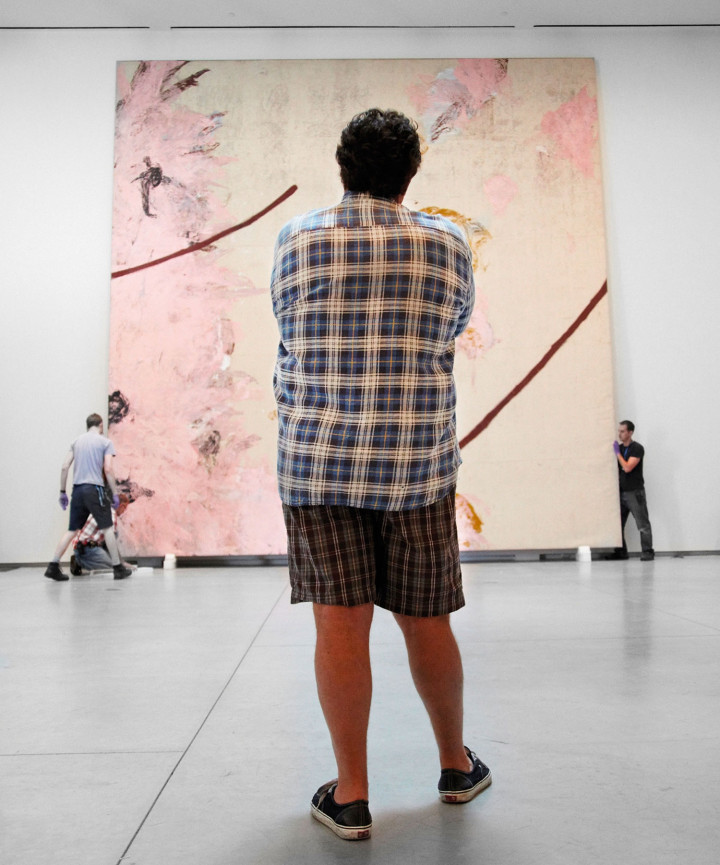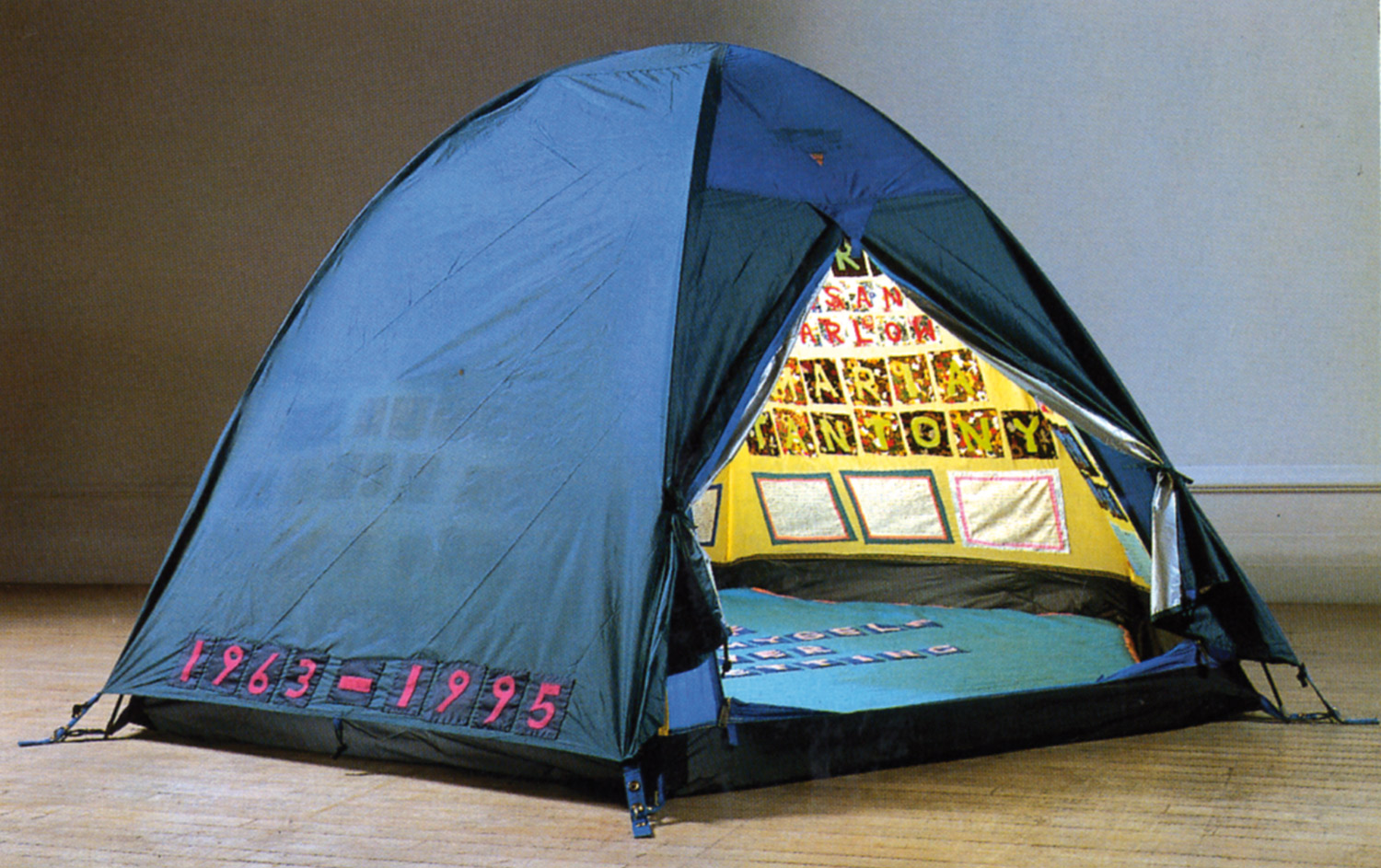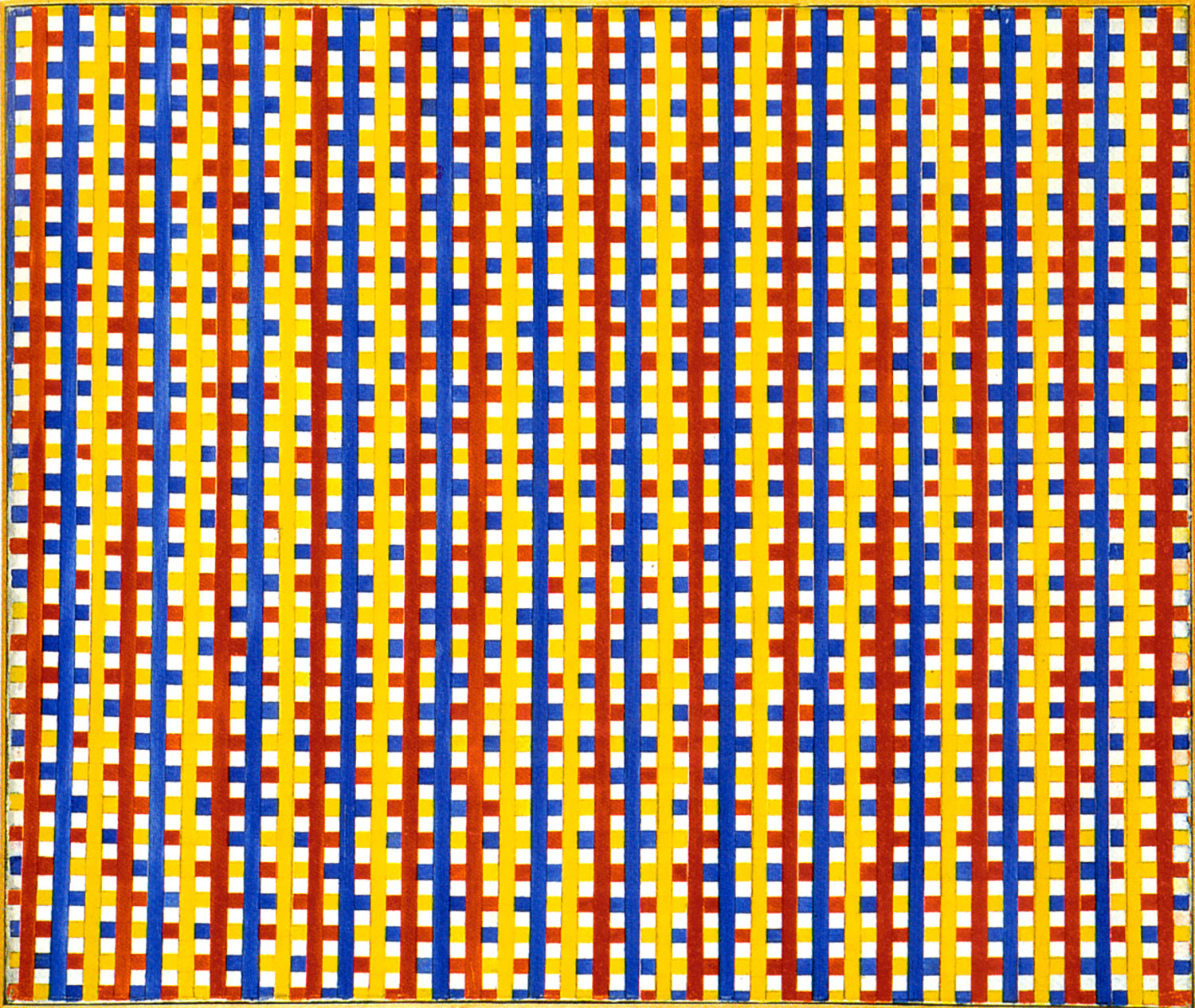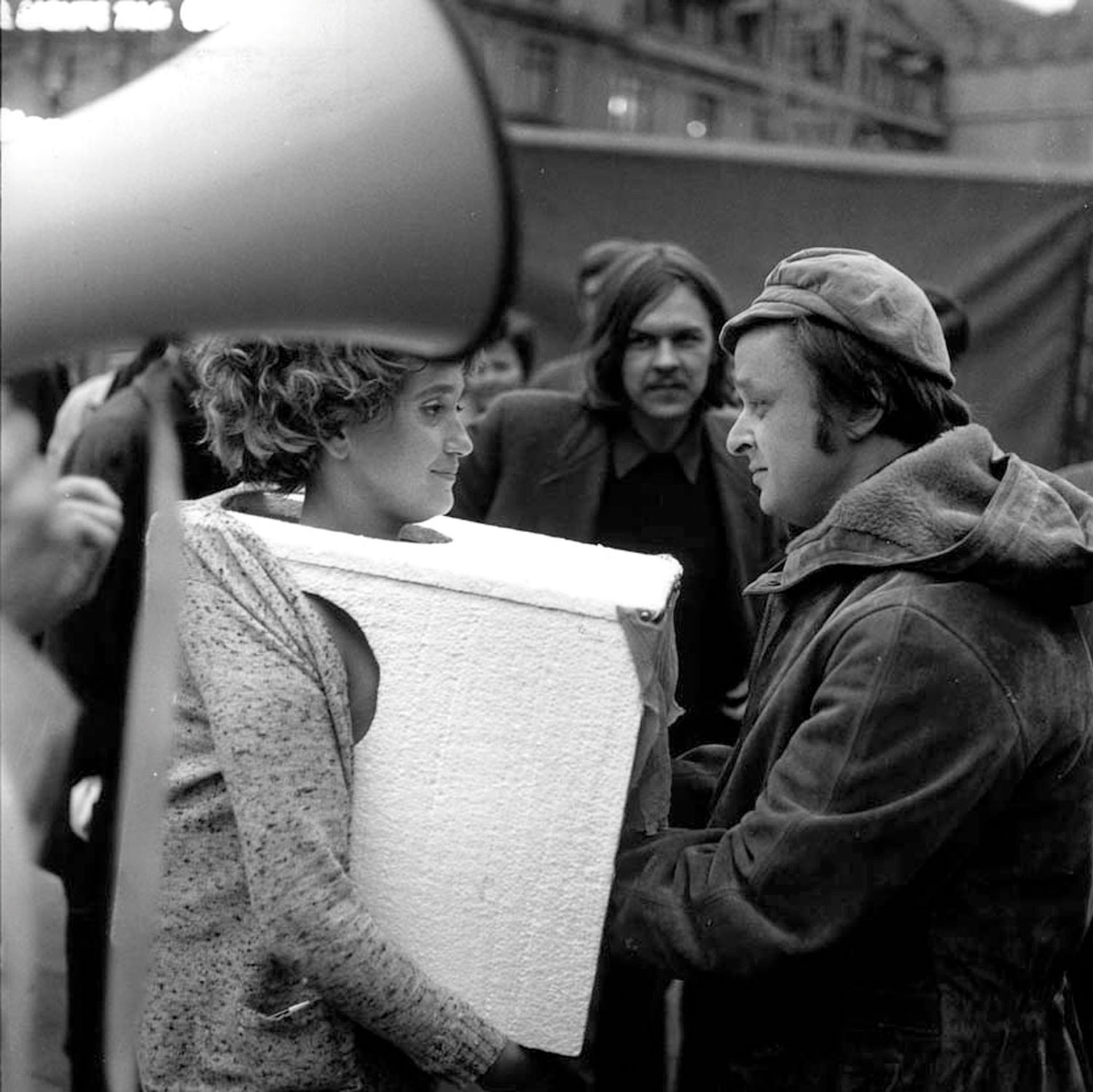
Edward Rubin: Your current exhibition “Julian Schnabel: Art and Film” at the Art Gallery of Ontario in Toronto is quite an eye opener. We know about your art — most prominently your broken plate paintings from the ’70s and ’80s — and we know about your film work, but the fact that film was on your mind at the very beginning of your painting career, and that many of your paintings refer to specific films like Pasolini’s Accattone, actors like Johnny Depp and Albert Finney, and film directors like Bernardo Bertolucci and Vittorio de Sica, comes as complete surprise. They say that our beginnings never know our ends, but in your case this seems to be something of a clue to your future as a filmmaker.
Julian Schnabel: Just like painting, going to the movies was an escape for me from the ordinariness of everyday life at home. Movies were more real to me than my life at home. As a child, I found The Ten Commandments, when Moses parted the Red Sea, totally awesome, and Moby Dick, when you get to see the great white whale’s eye, is terrifying. When I first saw Repulsion I realized a movie can really get inside of you. It could haunt you, and you could identify with it. I never thought I was going to be a movie director. However, when Jean-Michel died I wanted to tell his story and Basquiat (1996) was the result. Still, the core of everything I do comes from being a painter, and probably whatever qualities my movies have come from my perspective as a painter.
ER: Besides comparing you to Picasso — which you yourself did when you first gained notoriety — the art world still remembers your words, “I am as close to Picasso as you’re going to get in this fucking life.” A lot of critics cite the poet Walt Whitman when writing about you. You yourself frequently quote him.
JS: Well, I love when Whitman says in Leaves of Grass, “It’s ok if I contradict myself. I contain multitudes.” So, I think if you look at this show there’s a lot of different versions of what a painting can be, and obviously at a certain moment there’s a part of my brain, be it in a painting or a film, that’s a storyteller.
ER: As your popularity in the US lessened during the early ’90s, you began to exhibit widely in Europe. Your work — and your larger-than-life persona — seems to be, even today, better understood and a lot more respected in Europe than in the US. Is this true or am I imagining it?
JS: The deal is that we are living in a very myopic society and there is just enough fuel for whatever fire. Things get used up, and there is a whole new landscape of artists around and there are different reasons why people become popular or not. But the truth of the matter is that if whatever you are doing is useful, like in a utilitarian way, young artists in their 30s that are coming up now look at my work and I can use that. I know what to do. It comes late sometimes but now the ball comes back in my court and, you know, I kept my autonomy, I kept my freedom, I don’t owe anything to anyone. That can be construed as arrogant, but the point is that somehow I figured out a way to work and make a privilege for myself to work, and I’ll not compromise, not make movies where somebody says, “that’s good but we are going to change this around now and we have final cut.” I have the final cut on all of the films that I make.
ER: You seemed to have moved from painting to film with relative ease. With no obvious training in cinematic technique, casting or directing of actors. Still, you managed to create beautiful films like Before Night Falls (2000) and The Diving Bell and the Butterfly (2007), both of which garnered numerous international awards. I know that we all learn on the fly. Is that how you do it?
JS: Yeah! Sort of! I mean, obviously I know my subject. I think a lot of directors don’t know their subject. They know a craft and how to illustrate a script but they don’t know their subject. In filming Basquiat I wasn’t trying to make anything up. I’ve been in the basement with Jean Michel when he was painting. I’ve witnessed different kinds of injustice or different kinds of situations. I lived through it. Unfortunately he didn’t.

ER: Janusz Kaminski, your cinematographer on The Diving Bell and The Butterfly, said that because you are not restrained by formal training you’re able to discover and do things that ordinarily are not done. In your structuring of the film, especially in the way you duplicated Bauby’s way of seeing, by using fragmented images, gestural swipes and blurring shutter effects, you made cinematic magic. Can you talk a little bit about that?
JS: Sure! When somebody is paralyzed — like Jean Dominique Bauby is in The Diving Bell — and they know they can’t move their head (and you know they can’t move their head) that sets up some opportunities for somebody that’s making a movie about that character because the audience believes that they can’t move their head either. And if you can’t lift your head up, the director can cut somebody’s head off in the middle and somebody’s not going to think that you can’t control the camera. They’ll think, since Bauby can’t pick his head up, that what he’s actually seeing are the characters with their heads cut off. Bauby said that the only thing that is not paralyzed besides his eye, which sometimes had difficulty focusing, is his imagination. That ability to imagine allowed me, as when I am painting, a lot of freedom. The thing to remember is that whether it’s the movie screen or the canvas of a painting, this small rectangle is the battleground on which everything that you know and don’t know takes place. In film you are continually interpreting and translating. Painting is more like playing the saxophone. You hit a note. That’s it. You get it all at once. Movie making is about what goes next.
ER: You said that filmmaking for you is something of a side job. It really doesn’t pay the bills. You said that you make more money selling two paintings on a Sunday than you made in the whole year with one film. Were you talking about Basquiat?
JS: I was talking about The Diving Bell and the Butterfly. However, I’m not complaining because I get to do what I want to do, which is everybody’s dream. Painting has given me the freedom to make the films I want to make.

ER: In all of your films the protagonists, often with the odds stacked against them, are deep in battle, both physically and mentally. Still, with your painterly help, you managed to turn their suffering into something beautiful. You seem to be saying that their only hope of beating death is through their art.
JS: Life contains death but art doesn’t, because it is not life. It’s a representation of life. So, if it doesn’t contain death it’s a denial of death, and that’s why we say it’s an affirmation of life, no matter how tragic the character may be. Tarkovsky says there can never be pessimistic art; there can only be talent and mediocrity. And I think that he’s right. I don’t like to use words like “create,” “spiritual” or “inspiring,” but the truth is: how do you describe a film like Andrei Rublev? It’s so filled, somehow he’s located in the process, in the act of filming, something that is beyond language. That is what I try to do in both my paintings and films.
ER: Well, Diving Bell is beyond language.
JS: It’s also beyond logic. My paintings are sort of beyond logic too. There are things in them that you can recognize, but then somehow there is something else that goes on that commandeers whatever prior meaning it had, and takes it into some other place. That is something that I might not know the answer to.
ER: Your paintings are not as accessible as your films.
JS: You know why? If you can get all of the people that go to the movies to walk into a museum, there’d be no problem. But people are used to watching television at home or going to the movies. They’re not used to having an experience of standing in front of a painting. That’s almost an outdated experience. I don’t think you can judge the success or the quality of a work by how many people see it. But when it comes to movies, it certainly is if they make a billion dollars with a movie like Avapro or Avatar (Pleased with that joke we both laugh).
ER: In Sculpting in Time, Tarkovsky writes that he has distaste for the growing popularity of rapid-cut editing. He believed this to be contrary to the true artistic nature of cinema. In Diving Bell, the most artistic and leisurely edited of your films — to the extent of letting the audience feel both time and consciousness, their own as well as that of the paralyzed Bauby — you seem to agree with him.
JS: I think that I am a pretty old-fashioned movie director. I’m not using lots of special effects and not chopping things up. They’re very handmade.

ER: Before Night Falls was filmed in Mexico and New York City, The Diving Bell in France and Miral (2010) in Israel and Palestine. You seem to be attracted, and I might add very comfortable, with all things foreign: countries, writers, film locations not to mention beautiful women, two of whom you married, and one of whom you are currently living with. You even lived in Europe. What is your attraction to Europe?
JS: You know, sometimes I’ll write things on my paintings and somebody will say, “Why did you write that?” And I will say, “Don’t you like it when you go to the opera and everybody is signing in Italian and you don’t know what they are saying?” So I think there is some kind of pleasure in the foreignness of that. It’s such a drag when you understand everything.
ER: Your newest film, Miral, based on a book by Rula Jebreal, just previewed at the Toronto and Venice Film Festivals. It tells the story of the beginning of the Israel Palestine conflict from a pro-Palestinian view. This seems to be something of a departure for you. I mean, all of your other films, except perhaps for Before Night Falls, which takes place in Cuba, are neither controversial nor particularly political.
JS: I think all my films, like my paintings, are different. They’re all the same and they’re all different. So I think, in fact, this film ultimately is about a writer too. It is about a girl who ends up being a writer and gets to tell the story of what happened, and because she tells the story she can make people more aware. Actually it is not a pro-Palestinian movie. It is a pro-peace movie. And I think what is good for the Palestinians is good for the Israelis and vice versa.
ER: Do you destroy any of your work?
JS: Sure. These days I mainly paint over it. In 1977 I painted over so many paintings I only have seven paintings from that year. But I knew less about what I was doing at that time than I do now. Now I am comfortable not knowing what I am doing.
ER: Is there another film in the works?
JS: No. I don’t want to make a film for a while, I want to paint.





